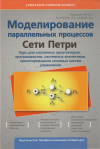New book has been published in Saint Petersburg, by Professional Literature.
Marakhovsky VB, Rozenblyum LYa, Yakovlev AV. Моделирование параллельных процессов. Сети Петри. (The book is in Russian language)(Modelling Concurrent Processes. Petri nets) . Saint Petersburg: СПб: Профессиональная литература, АйТи-Подготовка (Professional Literature, www.profliteratura.ru), 2014.
The book is in the Series of Selected Titles in Computer Science. It presents a course for Systems Architects and Programmers, Systems Analysts and Designers of Complex Control Systems.
Practically any more or less complex information or control system has components that operate concurrently, in other words in parallel. This book presents methods for formal dynamical modelling of parallel asynchronous processes. Such processes can be found in various application areas, such as computations, control, interfaces, programming, robotics or artificial intelligence.
It is emphasized in this book that there is an important relationship between a structural model, which reflects static properties of the modelled system, and its dynamic (behavioural) model. This two-pronged fundamental approach is suitable at all stages of system design – specification, analysis, implementation and verification.
The book has numerous examples and exercises, which makes it a good supporting text for courses in various syllabi involving modelling information and control systems.

